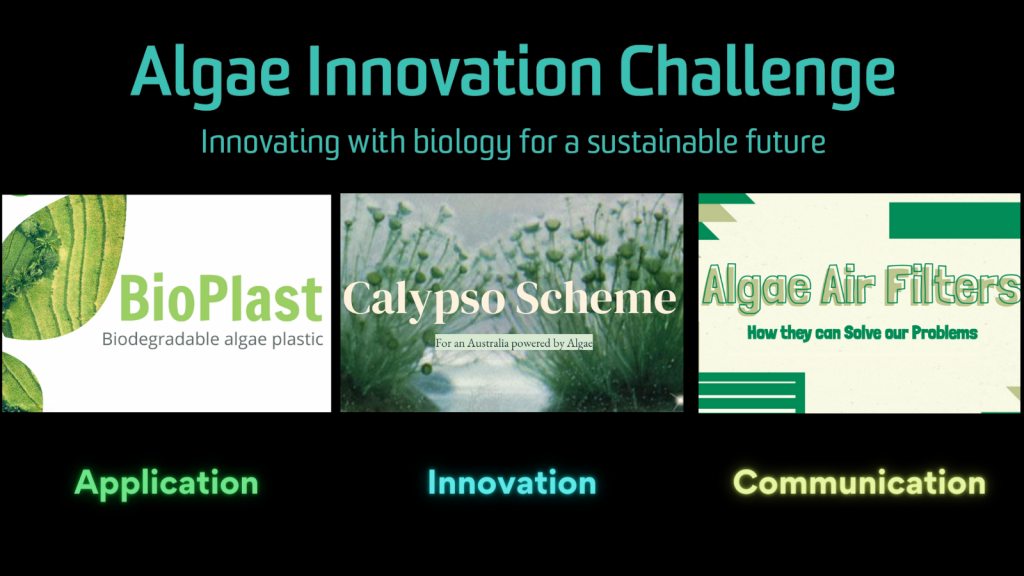The Algae Innovation Challenge started with a question. How can we grow a greener future with algae? Students were asked to design a product or a process, using algae, that makes an existing product or process more sustainable.
We had 20 school register for the inaugural Algae Innovation Challenge. This was a great response during a difficult period when schools were transitioning to learning from home.
We delivered a teacher information session and a live Q&A session for students to help teachers and students prepare and plan for their projects.
It was an absolute delight to hear from 26 inspiring and innovative young women from Bethlehem Catholic College Ashfield who pitched their game changing sustainability ideas as part of the Algae Innovation Challenge.
The panellist were looking at 3 key areas of Application, Innovation and Communication to determine the best submission. With solutions for bioplastic, air pollution and energy production – these students are set to play a pioneering role in creating a deepgreen future.

Algae Air Filters
Our idea of our product is algae air filters that will be used to purify the air so that the air pollution rate can decrease throughout the years to come, and for future generations. This product is to be filled up till ⅓ of the tank is full, and a handful of Chlorella Vulgaris is to be placed inside the tank. You then place the lid on top to secure the whole tank.
The problem this product is trying to solve is air pollution which is gradually increasing in Sydney every year. Air pollution will eventually get really bad in Sydney and to decrease this risk, our product can help slowly decrease the carbon dioxide emissions in our air. This specific type of algae called “Chlorella Vulgaris” is known to absorb more carbon dioxide quicker than any species of algae. Our idea of algae air filters will benefit our targeted audience of builders and company owners, especially in urban areas where the air pollutant levels are adequately high.
Future generations and present people in society will also continue to use our product to benefit themselves as well as the environment, since our product is used to purify the air, the air pollution rate in Sydney will decrease. Our product will become widespread in society through advertising and promoting as people will understand the benefits of this product. We hope that in the future this product won’t be limited to urban areas, but will be used across Sydney.
Students: Adelaide Powter, Elena Marino, Ninia Castro, Heena Minoguchi, Abigail Shrestha and Nicole Casupanan
The Calypso scheme
The Calypso scheme consists of three main initiatives including algae parks, green energy power plants and roof designs of algae. Algae parks will generally contain an algae pond with nicely fragranced plants to neutralise the smell but oxygen can increase.
Green power plants use algae as biofuel, and are processed in the same way as coal power plants. This makes it easier for current power plants to use the algae and all the while, does not release carbon emissions into the atmosphere, since other algae can be used to take in the carbon dioxide.
The roof designs can help reduce the amount of carbon in the atmosphere because with a vast majority of peoples contribution, there is a greater chance for change. The way it works is that the algae runs through the polycarbonate tube with pumps to help the algae flow. There is also a bioreactor connected to the tube so carbon dioxide can enter through there and be absorbed by the algae. A latch is placed towards the bottom of the bioreactor for the dehydrated algae, which is released and placed into a special bin to be sent off to the algae power plant. This then repeats the green power plant process again. The algae is also supplied by the government.
The Calypso Scheme utilises the C02 present in the earth’s atmosphere as well as alga’s photosynthetic properties to assist in our global warming and energy crisis. Algae is a renewable energy source which will allow for society to lessen our dependence on fossil fuels while also utilising the carbons in the atmosphere for energy.
The Calypso Scheme plans to enter the Australian society first to then be implemented as a global organisation.
Students: Amber Stanton, Avalokita Bhatta, Jiya Nair, Ella Luu, Nicole Vodrazka, Mia Rzepka-Hans, Prisha Pradhan, Tiffany Chui, Victoria Evran and Hayley Yuen.
BioPlast
Our idea is to create a biodegradable plastic through the use of algae. Plastics are used all throughout supermarkets, shops, household uses, school canteens, utensils, fast food restaurants and many more places throughout our daily lives. Our team is specifically looking at the use of BioPlast in school canteens for salad containers and food containers.
BioPlast will reduce the amount of plastic pollution in our Earth as our plastic takes only a matter of weeks to degrade compared to the many years it takes to degrade, it is also reusable because during the process of breaking down the plastic the algae within it can act as a fertiliser for soil.
Students: Catherine Pane, Chloe Dionisio, Madeline Ayoub, Antonia Nicolacopoulos, Christine Sahyoun, Jazmin Asinas-David, Jasmine El-Khoury, Sophia Leiva, Scarlett Cook and Lisa Diab.
I would like to thank all the panellist for their involvement throughout the project and the team from the Deep Green BioTech Hub.
Panelists
- Jestin George
- Emma Earley
- Ben Fraser
Deep Green BioTech Hub
- Melissa Oey
- Rachel Scott




